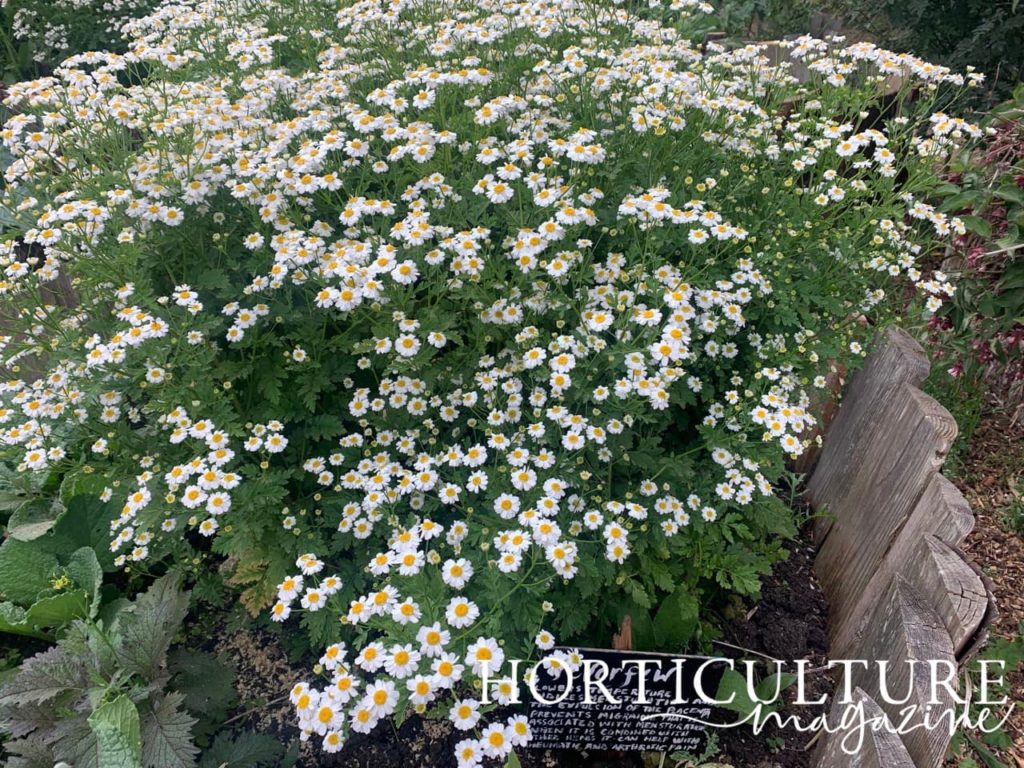HERBS > FEVERFEW
IN THIS GUIDE
FEVERFEW GUIDES

Feverfew is an attractive daisy - alike herbaceous perennial which can be both utile and attractive in a garden .
It ’s a beneficial choice for a repeated border , or in the guild of beneficial fellow traveller plants for fruit trees in your garden .
To benefit your plant , and the garden ecosystem as a whole , feverfew can often be a good choice .

Overview
PreferredFull Sun or Partial Shade
ExposureExposed or shelter
Height0.1 – 0.5 mebibyte

Spread0.1 – 0.5 M
Bloom TimeJune – August
PreferredLoam , sand

MoistureWell - enfeeble
pHAny
Feverfew , Tanacetum genus Parthenium , is a flowering plant in the Asteraceae ( Daisy ) plant family.1Tanacetum genus Parthenium . ( n.d . ) . North Carolina Extension Gardener Plant Toolbox . Retrieved March 15 , 2023 , fromhttps://plants.ces.ncsu.edu/plants/tanacetum-parthenium/

It is a low perennial which grows around 50 cm high , and has an eventual spread head of up to around 50 cm , with a bushy strain .
It has aromatic pinnately lob ovate farewell and expect little daisy - like prime with white flower petal and a yellow centre in the summertime months .
This plant is aboriginal to the Balkan Pensinsula , Anatolia and the Caucasus – but it is cultivated all over Europe and also vulgar in other character of the world.2Tanacetum parthenium . ( n.d.-b ) . Kew Royal Botanic Gardens . Retrieved March 15 , 2023 , fromhttps://powo.science.kew.org/taxon/urn:lsid:ipni.org:names:252460-1

Why Grow Feverfew?
Feverfew is an attractive decorative industrial plant that requires very picayune work , so it can be a great pick for a low - upkeep garden .
Though relatively curtly - lived , feverfew is a perennial plant that will grace your garden for a number of years – andsince it is a fertile self - cloud seeder , if you allow it to go to seed it should reseed itself in an area and total back for many years to add up .
“ In my own garden , I grew this plant from come once about ten years ago , ” explains Colin Skelly , a Master Horticulturist .

“ From the original five or six feverfews that were set , many century have since germinated , grown and lay out seed again .
“ Every twelvemonth I redact the seedling , keeping around 10 % of them . If I did n’t do this the feverfew would very rapidly spread and reign . ”
Further sowing will not usually be required as long as the plant life is growing in a desirable location .

Feverfew can bring several benefits while grow in your garden .
For example , it is suppose to naturally drive a range of insect pests while in alive ontogenesis ( though it must be said that this may be anecdotic and scientific evidence is lacking).3Agriculture | Province of Manitoba . ( n.d . ) . Feverfew . Retrieved March 15 , 2023 , fromhttps://www.gov.mb.ca/agriculture/crops/crop-management/print,feverfew.html
Some say that this make it a near companion plant for a range of other perennial industrial plant – you might also consider placing it close to a threshold or seating country to keep bothersome insect away .

Feverfew also provide a range of yields which can be utilitarian in the home and garden .
Here are some pic I took of Feverfew farm in the Glastonbury 2022 Permaculture Garden – a care and health garden go by Mike Feingold .
Feverfew Cultivars
In gain to growing the commonTanacetum parthenium , you could also consider some version .
Some popular named cultivars of Chrysanthemum parthenium include :
Botanical Name : T. parthenium‘Aureum ’

burnished lime - coloured leaves .
Botanical Name : T. parthenium‘Snowball ’
Puffy , Earth - shaped flowers in saturated Edward Douglas White Jr. .

Botanical Name : T. parthenium‘White Bonnet ’
Double flower in white with yellow centres .
How To Grow Feverfew
Feverfew is a quintessential cottage garden plant , and work well in informal andvaried bungalow garden - mode planting scheme .
It can work well in perennial borders , or in a dedicatedperennial herbaceous plant garden area .
Due to its pest - repelling dimension , feverfew may be beneficial for aphid controller near roses , or be included on the cheery fringe of a yield tree guild .
Feverfew does ask plenty of sunshine , so place it in full Lord’s Day .
It can manage with a locating that is exposed or sheltered – but does not contend well with nautical exposure .
One of the most crucial things to commemorate is that feverfew does need a well - drained loamy or arenaceous soil , though it is relatively unfussy when it comes to pH and birthrate .
In fact , it can even be grown in or on a stone wall and can also do well in containers providing that they provide sufficient drainage .
Feverfew seeds can be sow in from March indoors , or direct sown in the garden after all risk of freeze has overstep , in April or May .
Indoors sown industrial plant are engraft out between May and July .
The ejaculate should just barely be cut across , and it is crucial to make certain that the pot or ejaculate tray does not dry out out .
Once the seedling are expectant enough to cover , they can be pricked out into single plants to grow on before you implant them out into their final growing positions .
Feverfew can ferment well under rose bushes , and pairs well with hardy geranium ( cranesbill ) , clovers , andCerinthe major , as well as a range ofother traditional bungalow garden plant .
you’re able to also grow it in a herb garden with other perennial herbaceous plant – such as those Mediterranean herbs which also like free - draining conditions .
Feverfew Plant Care
Feverfew is a very light plant to develop and could easy take over your garden beds if you permit it , due to the ease with which it ego seeds .
This is a great choice for those who do not have a lot of meter to tend their garden , or who would like to rapidly reach a garden with an abundant smell and feel .
Once feverfew is in its final growing post in your garden , it will be comparatively drought tolerant and will only require lacrimation in extremely ironical precondition , or when it is grown in container .
The soil should be damp but must be free draining – it is important not to overwater your plants .
feast Tanacetum parthenium is unneeded , and in fact , this is a plant life that can thrive in poor conditions .
Deadheading feverfew will forestall the industrial plant from self - seeding prolifically .
So if you want to keep these more stop , then deadhead the plants before seed bod .
Alternatively , amass the come from the plant life so you may control where you want them to go and engraft them next year .
Or simply let the plants self - seminal fluid for a more natural and low - maintenance scheme .
If you want to make new plants from the existing feverfew plants in your garden , you’re able to dissever the plant life as you would other herbaceous perennials to make unexampled works .
However , it is important to note that divided plant do not typically endure very long , so this is not usually very useful .
Save the seeds to spread new plants , or , as cite above , get them ego - seed and permit nature do the employment for you .